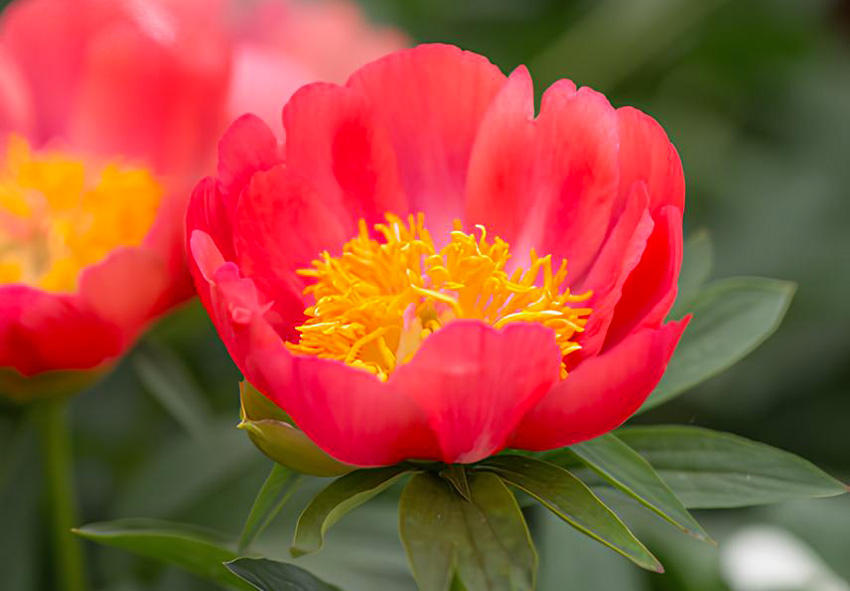Anemone Peonies: Care Guide for Flower
Anemone Peonies are a stunning and unique variety of peony, admired for their eye-catching floral structure and vibrant coloration. Unlike traditional single or double peonies, Anemone Peonies are characterized by their distinct centers—fluffy and frilled with petaloid stamens—that give them a soft, tufted appearance. Surrounding these textured centers are broad, colorful outer petals that provide a beautiful contrast, making each bloom look like a living work of art.
These flowers are especially prized in gardens and floral arrangements due to their long-lasting nature and strong visual appeal. Their upright stems and compact, bushy form make them ideal for both borders and containers. Anemone Peonies bloom in late spring to early summer and can thrive for decades when properly cared for. Their mix of charm and hardiness has made them a favorite among gardeners and florists alike, perfect for adding elegance and whimsy to any outdoor or indoor space. Our gardening blog is a perfect place to find all the information you need!
Why Choose Anemone Peonies for Your Garden or Home?
Anemone Peonies offer a perfect blend of beauty, durability, and low-maintenance care, making them an excellent choice for any garden or home. Their standout feature—the frilly, full centers surrounded by silky outer petals—adds unique texture and sophistication to garden beds, borders, and floral arrangements. Available in an array of vibrant colors from soft pastels to rich pinks and reds, Anemone Peonies can suit any design style, from romantic cottage gardens to modern minimalist landscapes.
In addition to their aesthetic appeal, Anemone Peonies are known for their impressive longevity and resilience. Once established, these plants require minimal maintenance and can bloom reliably each year for decades. Their foliage stays lush and attractive throughout the growing season, adding green structure to the garden even after flowering ends. They’re also naturally resistant to many common pests and diseases, making them a dependable choice for gardeners of all experience levels. Their blooms are excellent as cut flowers, offering a long vase life and making any arrangement feel luxurious. Whether you’re looking to create a bold statement or a soft, dreamy look, Anemone Peonies provide both reliability and breathtaking beauty.
The Most Popular Anemone Peonies Varieties and Their Characteristics
Anemone Peonies come in a dazzling variety of colors and forms, with each type offering a different expression of beauty. Among the most beloved varieties is ‘Do Tell’, a show-stopping peony with soft pink outer petals and a contrasting cluster of creamy yellow and rose petaloids in the center. Its delicate palette and open-faced bloom make it a garden favorite. ‘Bowl of Beauty’ is another classic, featuring a vivid magenta-pink outer layer and a ruffled cream center that commands attention from across the yard.
For gardeners who prefer softer shades, ‘Nippon Beauty’ offers a deep red bloom with a halo of silvery stamens, ideal for adding drama and elegance. On the more delicate side, ‘Prairie Charm’ blends buttery yellow tones with gentle textures. These varieties not only differ in color but also in size, fragrance, and blooming time, allowing gardeners to stagger their display for extended color throughout the season. Anemone Peonies work wonderfully in mixed borders, cottage gardens, or as focal points in perennial beds. Thanks to their structural beauty and diverse palette, they also shine in floral arrangements, either fresh or dried. With so many exquisite options, there’s an Anemone Peony for every aesthetic and garden style.
Classic Pink Anemone Peonies
Pink Anemone Peonies are timeless garden favorites, offering a soft, romantic look that fits beautifully in any landscape. Their layered petals and fluffy centers provide texture and visual interest, while the various shades of pink — from pale blush to vibrant rose — allow for versatility in garden design. These varieties also make outstanding cut flowers thanks to their striking form and long vase life. Here are some beloved pink Anemone Peonies:
- ‘Embraceable Pink ’: A well-known classic, this variety has bold fuchsia-pink outer petals surrounding a creamy yellow center, creating an impressive contrast.
- ‘Do Tell’: Elegant and refined, ‘Do Tell’ features soft pink petals with a central tuft of rose and cream-colored stamens.
- ‘White Cap’: A brighter, purple-pink hybrid with a full anemone form, known for its early blooming and fragrant blossoms.
Each of these varieties adds a soft, feminine charm to garden beds and floral arrangements.
White and Cream Anemone Peonies for Elegant Gardens
White and cream Anemone Peonies bring a sense of serenity and grace to garden spaces. Their delicate shades brighten shady spots and complement more vivid colors in mixed borders. With their frilled centers and smooth outer petals, these blooms create a clean, classic look that works especially well in formal gardens and monochrome floral designs. Consider these standout white and cream varieties:
- ‘Primevere’: A unique creamy-white peony with large, ruffled creamy centers surrounded by white petals — dramatic yet sophisticated.
- ‘Cheddar Surprise’: This creamy yellow-white variety has a warm, buttery center and slightly ruffled petals, ideal for softening garden palettes.
- ‘Clearstream’: A true white variety with a compact habit and prominent anemone-style center, perfect for smaller garden beds.
These elegant peonies are also stunning in bridal bouquets and refined floral arrangements.
Red and Deep Burgundy Anemone Peonies for Bold Statements
For those looking to add drama and richness to their garden, red and deep burgundy Anemone Peonies deliver stunning impact. These vibrant, intense blooms make bold focal points, especially when paired with lighter companions. Their deep colors also hold well in arrangements, offering sophistication and romance. Here are some powerful varieties to consider:
- ‘Scarlet O’Hara’: A striking red single peony with a golden center, known for its vigor and vibrant presence.
- ‘Henry Bockstoce’: Though often considered a semi-double, this deep burgundy beauty features large, lush blooms with strong stems for cutting.
- ‘Karl Rosenfield’: A ruby-red classic with a bright yellow stamen center, excellent for creating contrast in borders.
These varieties are ideal for creating eye-catching garden moments or rich-toned floral bouquets.
Unique and Bi-Colored Anemone Peonies
If you’re seeking a truly unique touch in your garden or flower arrangements, bi-colored Anemone Peonies offer captivating contrasts and rare beauty. Their two-toned petals and vibrant centers make them stand out among more traditional varieties. Here are some remarkable options for something a little different:
- ‘Pink Hawaiian Coral’: A coral-peach bloom with a sunny yellow center, this semi-double peony has strong color shifts as it matures.
- ‘Cora Louise’: A standout Itoh hybrid, this peony has creamy white petals with a striking purple flare at the base and a golden anemone center.
- ‘Gay Paree’: Known for its soft purple-and-white marbled petals with unique form, this rare variety is both playful and elegant.
These exotic-looking varieties are perfect for gardeners wanting an unconventional twist on classic peonies.
How to Plant and Grow Anemone Peonies Successfully
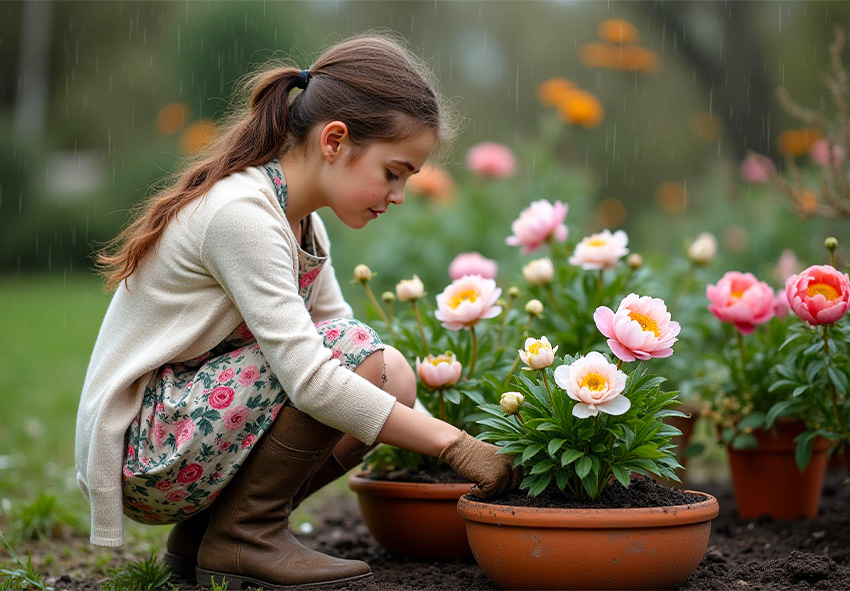
Planting and growing Anemone Peonies can be a rewarding experience, especially when their showy blooms begin to unfurl in spring and early summer. To ensure success, start by selecting healthy, firm peony roots with visible buds—these are signs of strong, viable plants. Avoid any that feel soft or shriveled, as these may struggle to grow.
Choose a sunny location where your peonies will receive at least six hours of direct light each day. The soil should be well-draining and rich in organic matter, ideally with a slightly acidic to neutral pH. Before planting, loosen the soil and mix in compost to provide nutrients and improve drainage.
When planting, place the root just one to two inches below the soil surface with the buds pointing upward. Space each plant about three feet apart to ensure air circulation and future growth. Water thoroughly after planting, keeping the soil moist but never soggy.
As your peonies settle in, protect young shoots from harsh winds and frost. Apply a light mulch to retain moisture and regulate soil temperature. With patience and care, your Anemone Peonies will flourish, returning year after year with their lush foliage and distinctive, ruffled blooms.
Step-by-Step Guide to Planting Anemone Peonies
Planting Anemone Peonies requires a little patience and attention to detail. From selecting healthy roots to ensuring the ideal soil and planting depth, each step plays a role in setting your peonies up for success. Follow the guide below to help your Anemone Peonies establish strong roots and grow into vibrant, blooming plants.
Step 1: Choosing Healthy Anemone Peony Roots or Tubers
Begin by selecting robust, healthy roots or tubers that are firm to the touch and free from mold or visible damage. Look for multiple “eyes” or growth points, which are small reddish buds on the crown of the root. These are essential for sprouting and developing strong stems. Avoid purchasing peony roots that appear overly dried, shriveled, or mushy, as they may not establish well in the soil. The healthier the tuber, the more vigorous the growth will be in the first season and beyond. If buying online or from a garden center, opt for reputable sellers who specialize in peonies and ship their roots during the appropriate planting season—typically fall or very early spring.
Step 2: Choosing the Right Soil and Location
Anemone Peonies thrive in well-draining, fertile soil with a slightly acidic to neutral pH between 6.5 and 7.0. The planting site should receive at least six hours of direct sunlight daily, as full sun promotes robust flowering and prevents leggy growth. However, in hotter climates, a location with some afternoon shade can help protect the blooms from fading. Before planting, work compost or well-rotted manure into the soil to enrich it and improve drainage. Avoid heavy clay or soggy areas, as overly wet soil can lead to root rot. Raised beds or sloped areas with good air circulation are especially beneficial for healthy peony growth.
Step 3: Proper Planting Depth and Spacing
When planting Anemone Peony tubers, position them so that the eyes (buds) are facing upward and sit no more than one to two inches below the soil surface. Planting too deep can delay blooming or prevent flowering altogether. Cover the roots gently with soil, firming it lightly to eliminate air pockets without compacting it. It’s also important to give each plant enough room to grow—space them at least three feet apart. This ensures proper air circulation around the foliage, reducing the risk of disease and allowing the plants to mature into full, rounded clumps. Peonies do not like to be disturbed once established, so thoughtful placement at the start will pay off in healthy, long-lived plants.
Step 4: Watering After Planting
After planting, water the area thoroughly to settle the soil around the roots. This initial watering helps eliminate air gaps and encourages the roots to establish quickly. While it’s important to keep the soil moist during the first few weeks of growth, be cautious not to overwater. Anemone Peonies are sensitive to soggy conditions, which can lead to root rot. Going forward, water only when the top inch of soil feels dry, allowing it to dry out slightly between waterings. Good drainage is key—using mulch can help retain moisture while still allowing air to reach the roots. During periods of extended drought or heat, increase watering slightly to support healthy foliage development.
Step 5: Providing the Right Conditions for Growth
Once planted, young Anemone Peonies benefit from extra protection as they settle in. Shield them from strong winds that could snap tender stems, and be cautious of late spring frosts that might damage emerging shoots. A light layer of mulch helps regulate soil temperature and retain consistent moisture, which is especially helpful during unpredictable spring weather. As the plants mature, peonies become more resilient, but it’s still a good idea to monitor for sudden weather changes. Avoid fertilizing heavily in the first year, allowing the roots to focus on establishment. With time and anemone peony bulb care, these flowers will reward you with lush foliage and their signature anemone-style blooms each season.
Essential Anemone Peony Care Tips for Healthy Growth
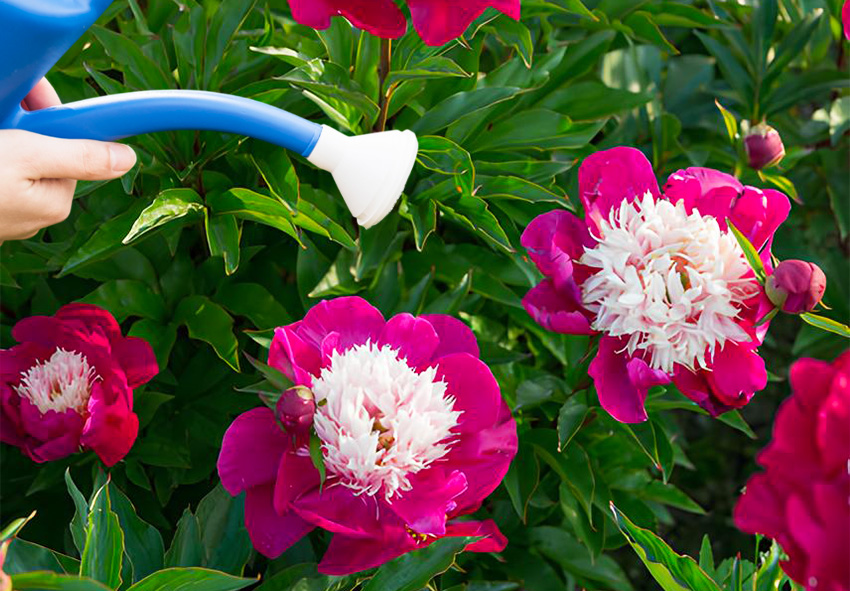
Anemone Peonies are beloved for their showy blooms and lush foliage, but to keep them looking their best, they need the right care throughout the growing season. These perennials thrive in full sun, needing at least six hours of direct sunlight daily, though they can tolerate light afternoon shade in hot climates. Plant them in well-draining, fertile soil with a neutral to slightly acidic pH between 6.5 and 7.0. Avoid overly wet areas, as waterlogged soil can lead to root rot.
Water deeply once a week, allowing the top layer of soil to dry slightly between waterings. Avoid overhead watering to reduce the risk of fungal disease. In early spring, feed plants with a balanced, slow-release fertilizer (10-10-10), stopping once flowering begins.
Support taller stems with rings or stakes to keep heavy blooms upright. Deadhead spent flowers to promote a longer bloom season and maintain a tidy appearance. Protect new shoots from late frosts and apply a layer of mulch to retain moisture and regulate soil temperature.
With the right combination of light, water, nutrition, and protection, Anemone Peonies will thrive, returning each year with vibrant blooms that add elegance and charm to any garden or floral display.
How to Care for Anemone Peonies After Planting
It’s important to know how to care for anemone peonies in the garden just as learn how to care for anemone peonies indoors. After planting Anemone Peonies, establishing a regular care routine is crucial. These elegant flowers require balanced watering, feeding, protection from extreme conditions, and occasional support for tall stems. With the right approach, they’ll reward you with season after season of vibrant, long-lasting blooms and lush, healthy foliage.
Step 1: Watering Anemone Peonies the Right Way for Healthy Roots and Blooming
Proper watering is essential to the development and longevity of Anemone Peonies. These plants prefer deep watering once a week, which encourages strong root growth and minimizes shallow roots that are vulnerable to heat and drought. Let the top inch of soil dry out slightly between watering to prevent soggy conditions, which can lead to root rot. The goal is to maintain even soil moisture, not wetness. Always water at the base of the plant to avoid wetting the foliage, as damp leaves can lead to fungal problems like botrytis.
In particularly rainy seasons, ensure the soil drains well to avoid waterlogging. During hot spells or dry periods, increase watering slightly while still monitoring soil moisture. As peonies mature, they become more drought-tolerant, but regular watering during the blooming period supports larger and more vibrant flowers. Consistent hydration is a simple yet powerful step in encouraging a thriving, bloom-heavy plant.
Step 2: Fertilizing for Strong Growth and Vibrant Flowers
Fertilizing Anemone Peonies properly helps build a strong plant that can produce large, showy blooms. Begin in early spring as soon as new shoots appear, using a balanced, slow-release fertilizer such as a 10-10-10 formula. This combination ensures even support for root development, leaf production, and bud formation. Apply fertilizer around the drip line of the plant, not directly on the crown or stems, to avoid burning tender new growth. Always water well after fertilizing to help nutrients penetrate the soil and reach the roots.
Avoid overfeeding, as too much nitrogen can lead to excessive leaf growth and fewer flowers. Once the flower buds are well developed and beginning to open, stop fertilizing to allow the plant to focus its energy on blooming rather than growing new foliage. With consistent feeding during the early growth stages, your Anemone Peonies will reward you with robust stems, healthy leaves, and an abundance of blossoms.
Step 3: Providing Proper Light and Temperature for Thriving Peonies
Light and temperature play a vital role in the success of Anemone Peonies. These plants thrive in full sun, ideally receiving at least six hours of direct light per day. In hotter climates, however, they benefit from afternoon shade, which can prevent wilting and help flowers retain their color longer. Cool to moderate temperatures—ranging between 15°C and 24°C (59°F to 75°F)—support healthy growth and optimal flowering. Peonies are naturally cold-hardy and even require a winter chilling period to trigger blooming in spring.
In regions with harsh winters, protect the crown with a light mulch layer in late fall to prevent frost damage. Be sure to remove mulch in early spring to allow new shoots to emerge easily. Sudden temperature fluctuations or exposure to extreme heat can cause stress, resulting in smaller flowers or stunted growth. By managing both sun exposure and seasonal temperature changes, gardeners can maintain strong, flowering Anemone Peonies year after year.
Step 4: Supporting Tall Stems and Prolonging the Blooming Period
Though Anemone Peonies often have sturdy stems, certain taller cultivars and those grown in windy or rainy environments may need support to remain upright. Heavy rain or large blooms can cause stems to bend or break if unsupported. To avoid this, use peony rings, cages, or gentle stakes early in the season before the plants grow too tall. Position supports around the base of the plant and allow the stems to grow through, offering natural reinforcement as they develop.
In addition to structural support, routine deadheading of faded blooms helps extend the flowering period and encourages energy to be redirected into root and bud development. Gently snip off each spent flower just above a leaf node. This not only keeps the plant looking tidy but also helps prevent seed production, which can sap energy. Consistently supporting and grooming your peonies ensures a longer, healthier, and more vibrant display of flowers throughout the blooming season.
How to Encourage Your Anemone Peonies to Bloom Again
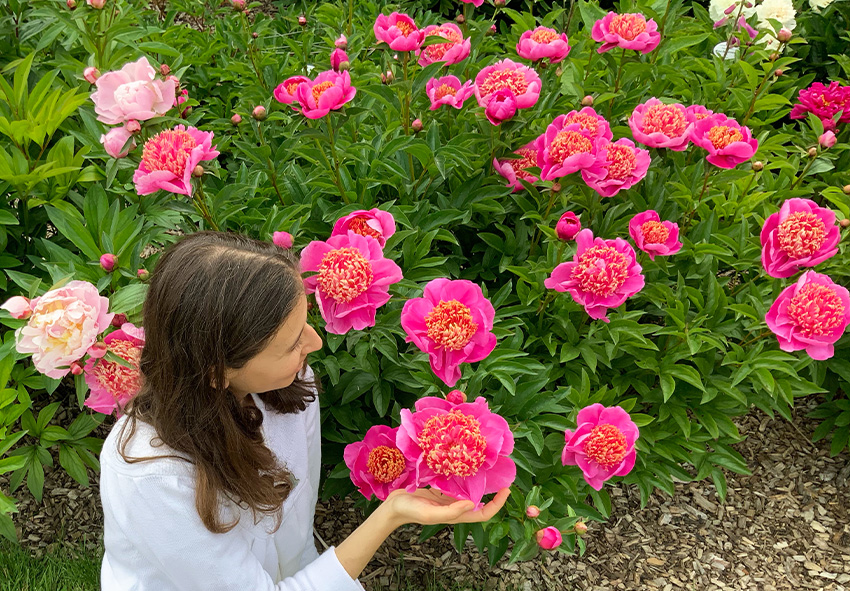
Anemone Peonies are admired for their intricate, fluffy centers and vibrant petals, making them a favorite among gardeners and floral designers alike. However, getting them to bloom year after year requires careful post-bloom care and seasonal maintenance. When these peonies fail to flower again, the reasons often lie in overlooked factors such as insufficient sunlight, lack of nutrients, improper pruning, or overcrowded roots. To ensure your Anemone Peonies rebloom with the same brilliance, it’s essential to follow a step-by-step approach focusing on plant health and energy conservation.
Begin by deadheading spent blooms right after flowering. This prevents the plant from diverting energy into seed production and instead allows it to focus on root and bud development. Leave the foliage intact until it yellows naturally, as it plays a key role in photosynthesis and storing energy for next season.
As fall approaches, prepare your plants for dormancy by cutting back dead foliage and applying a light layer of mulch to insulate the roots during winter. This protection is especially important in colder climates, where frost can damage dormant roots.
Every 5 to 10 years, divide mature peony clumps to prevent overcrowding and promote airflow. Replant divisions in nutrient-rich, well-drained soil, spacing them adequately for optimal growth.
Lastly, ensure the peonies are planted in full sun and are fertilized early in the growing season. A balanced fertilizer will strengthen the roots and promote bud development. With these practices in place, your Anemone Peonies will be primed to bloom again beautifully year after year.
Step-by-Step Guide to Ensuring Reblooming
To help your Anemone Peonies bloom again in the next season, focus on proper maintenance after flowering. This includes deadheading, winter preparation, and dividing mature plants when needed. These steps ensure the plant channels energy into root and bud development instead of seed production, setting the stage for another showy bloom cycle.
Step 1: Deadheading and Post-Bloom Care
Deadheading Anemone Peonies is an essential part of encouraging them to bloom again the next year. Once flowers begin to fade and lose their vibrant color, use clean, sharp garden shears to snip the flower stem just above the first set of full leaves. This prevents the plant from using energy to produce seeds, redirecting that energy into strengthening the roots and storing nutrients for next season’s blooms. Continue to water the plant regularly after blooming and avoid cutting back any green foliage until it begins to yellow naturally. Healthy leaves play a vital role in photosynthesis and energy storage. Post-bloom feeding with a mild, balanced fertilizer can also support this recovery phase. Taking the time to care for your peonies properly after flowering increases their chance of producing even more abundant blooms the following year.
Step 2: Preparing Anemone Peonies for Winter
Proper winter care is crucial to ensure your Anemone Peonies come back strong and ready to bloom again. In late fall, once the foliage has turned yellow and died back naturally, cut the stems down to ground level. This helps prevent fungal diseases and removes any pests that might overwinter in the debris. After trimming, apply a light layer of mulch, such as shredded bark or straw, around the base of the plant. This acts as insulation against harsh winter temperatures and helps retain soil moisture. Avoid piling mulch directly against the crown of the plant to prevent rot. In regions with mild winters, mulching may be minimal, but in colder zones, it offers valuable protection. Come spring, remove any excess mulch to allow new shoots to emerge easily. Winter preparation ensures your peonies rest well during dormancy, preserving their strength and setting them up for healthy regrowth and bloom production.
Step 3: Dividing and Transplanting Anemone Peonies
Over time, Anemone Peonies can become overcrowded, leading to fewer blooms and weaker plants. Dividing mature peony clumps every 5 to 10 years can reinvigorate them and restore their flowering potential. The best time to divide peonies is in early fall, after the foliage has died back but before the ground freezes. Start by carefully digging up the entire plant, taking care not to damage the roots. Wash off the soil to reveal the root system and identify natural divisions, which typically include at least 3 to 5 “eyes” or buds. Use a clean, sharp knife to separate the divisions. Replant each section in well-draining, nutrient-rich soil, positioning the buds about 1 to 2 inches below the surface. Water thoroughly after planting. Dividing peonies not only helps rejuvenate old plants but also gives you the opportunity to expand your garden or share with friends. Healthy spacing also reduces disease and improves airflow.
Common Problems with Anemone Peonies and How to Fix Them
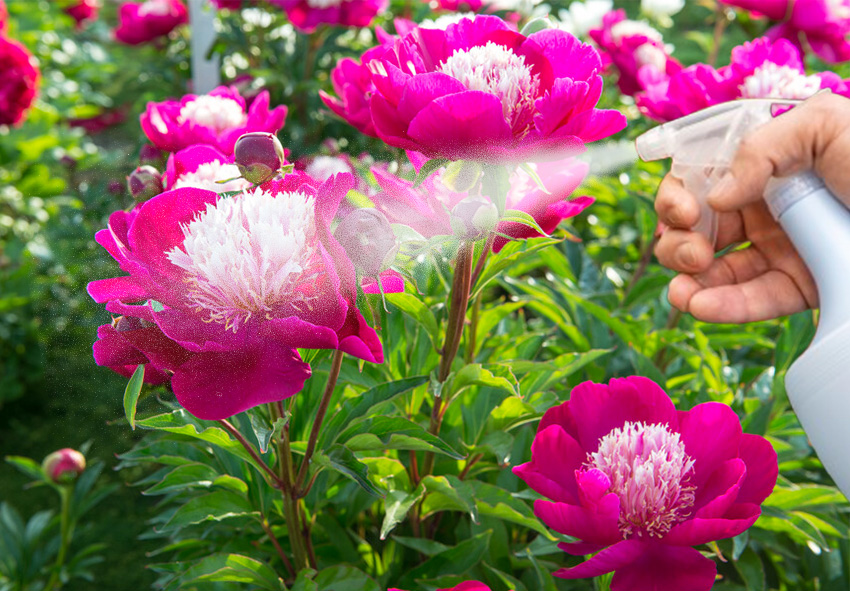
Anemone Peonies are beloved for their stunning blooms and resilience, but like all plants, they can encounter problems that may affect their growth and flowering. Identifying these issues early and knowing how to address them can ensure your peonies thrive in your garden. Common problems include poor blooming, yellowing leaves, and pest infestations. These issues may arise from environmental factors, improper care, or diseases. Fortunately, most problems can be resolved with the right care.
Understanding the causes behind these issues, such as nutrient deficiencies, overwatering, or inadequate sunlight, can help you take the appropriate steps to fix them. Whether it’s adjusting your watering routine, ensuring proper drainage, or using organic treatments for pests, proactive care can make all the difference. Regular maintenance, such as deadheading spent blooms, ensuring the plant receives adequate sunlight, and applying the right fertilizers, will encourage healthy growth and vibrant flowers.
By following proper care techniques, your Anemone Peonies can flourish year after year. Whether you’re a seasoned gardener or a beginner, addressing these common problems will lead to beautiful, long-lasting blooms and a healthier garden overall. With a little attention, your Anemone Peonies can continue to be a stunning focal point in your garden or home.
Troubleshooting Guide
If your Anemone Peonies aren’t thriving, several factors could be at play. Common problems include failure to bloom, yellowing foliage, pest infestations, and fungal diseases. With the right care, soil, and preventative measures, most of these concerns can be avoided or quickly resolved to restore the plant’s health and beauty.
Issue 1: Anemone Peonies Not Blooming
Anemone Peonies are beloved for their vibrant blooms, but sometimes they may fail to flower. This issue can arise due to improper planting depth, insufficient sunlight, or excessive fertilization. A lack of blooms is often a sign that something is affecting their ability to thrive. Fortunately, with the right adjustments, you can encourage these beautiful plants to bloom. Below are the common causes and effective solutions to restore blooming to your Anemone Peonies.
Cause:
- Planted too deep
- Lack of sunlight
- Overfertilization
Solution:
- Replant the peonies shallower, ensuring the crown is just below the soil surface.
- Move the peonies to a sunnier spot with at least 6 hours of direct sunlight daily.
- Reduce nitrogen-rich fertilizers, as they promote leafy growth over blooming. Use a balanced fertilizer with more phosphorus and potassium for flower production.
Issue 2: Yellowing Leaves or Weak Growth
Yellowing leaves and weak growth are common issues for Anemone Peonies, often signaling stress. These symptoms may arise from improper watering or poor drainage, both of which affect the roots and overall health of the plant. Understanding the cause of yellowing leaves will allow you to take the right steps toward restoring vigor to your peonies. Below, we’ll explore the reasons behind yellowing leaves and provide tips to improve the health of your plants.
Cause:
- Overwatering
- Poor soil drainage
Solution:
- Improve soil drainage by amending the soil with organic matter like compost or using raised beds for better water flow.
- Water the peonies less frequently but deeply, ensuring the soil is allowed to dry slightly between waterings.
- Avoid watering directly on the leaves to prevent fungal diseases and root rot.
Issue 3: Peonies Falling Over
One of the most frustrating issues with Anemone Peonies is when the plants’ large, heavy blooms cause them to topple over. This can happen when peonies are not properly supported, especially when they begin to bloom and the weight of the flowers becomes too much for the stems. The good news is that with a little proactive care, you can keep your peonies upright and healthy. Here are the causes behind peonies falling over and simple solutions to support their growth.
Cause:
- Large blooms without proper support
Solution:
- Use plant cages, stakes, or trellises to support the stems before the blooms open.
- Position supports carefully to avoid damaging the stems.
- Choose sturdy varieties or prune large flowers to reduce weight if necessary. Adding mulch can also help stabilize the plant’s base.
Frequently Asked Questions (FAQs) about Anemone Peonies
1. What are Anemone Peonies and how are they different from other peonies?
Anemone Peonies are a unique type of herbaceous peony known for their distinct, ruffled center petals surrounded by flatter outer guard petals. The inner petals often resemble a fluffy puff, giving the bloom a textured, full appearance. Unlike traditional single or double varieties, Anemone Peonies offer a striking, sculptural look that adds dimension to garden beds and floral arrangements.
2. Can I order Holland Anemone Peonies from your online store?
Yes, you can! Our online store Dutch-bulbs.com offers high-quality Anemone Peonies grown in Holland, known for their vibrant colors and excellent bloom quality. Our bulbs are carefully selected and shipped at the optimal planting time to ensure successful growth. Visit our online store to browse the current selection of Anemone Peony varieties and place your order with confidence.
3. How much sunlight do Anemone Peonies need?
Anemone Peonies thrive in full sun, requiring at least 6 hours of direct sunlight each day. While they can tolerate light afternoon shade, too little light may result in fewer or smaller blooms. When growing indoors, place them near a bright, south-facing window or supplement with a grow light to mimic natural sunlight.
4. How do I care for Anemone Peonies after they bloom?
After blooming, deadhead spent flowers to direct the plant’s energy into root and foliage growth. Keep the foliage intact throughout summer and fall—it helps strengthen the plant for the next blooming season. In late fall, once leaves have yellowed and died back naturally, cut stems to the ground. Apply mulch over the root zone for added winter protection, especially in colder regions.
5. Can Anemone Peonies grow in containers or indoors?
Yes, Anemone Peonies can be grown in large containers, but they need plenty of space for root development and good drainage. Choose a deep pot, use nutrient-rich soil, and ensure it receives full sunlight. While they can be grown indoors in bright conditions, outdoor growing is generally more successful. Container-grown peonies may require more frequent watering and feeding to support healthy blooms.
Published: 18.04.2025

